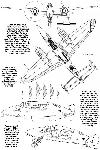Фотографии
-
Displaying its minimal frontal area - and resembling the USA’s late-war-vintage Grumman F7F Tigercat naval fighter - the prototype SE.100 has its Gnome-Rhone 14N engines run up during trials. Note the highly unusual arrangement in which the mainwheels retract into the twin fins.
Самолёты на фотографии: Sud-Est SE.100 - Франция - 1939
-
Groundcrew prepare the prototype for a test flight at Villacoublay, from where the aircraft made 33 flights, all in the hands of Louis Rouland, between March and December 1939.
Самолёты на фотографии: Sud-Est SE.100 - Франция - 1939
-
This view of the prototype SE.100 in the SNCASE workshop at Argenteuil, undergoing final modifications to the hydraulic system, emphasises the type’s banana-shaped fuselage. Mercier’s design very much lived up to the specification of a thoroughly modern fighting aircraft, but its complex curves made it challenging to build.
Самолёты на фотографии: Sud-Est SE.100 - Франция - 1939
-
The SE.100 was designed to be constructed from non-strategic materials as much as possible, with a metal frame providing the skeleton for a specially designed rigid plywood skin arranged in easily demountable panels for easy access.
Самолёты на фотографии: Sud-Est SE.100 - Франция - 1939
-
The sharply curved rear fuselage of the SE.100 incorporated a channel in which the barrel of the 20mm Hispano-Suiza HS.404 cannon could be accommodated when not in use. The photograph on the right shows the cannon and gun position when extended.
Самолёты на фотографии: Sud-Est SE.100 - Франция - 1939
-
On December 9, 1939, the SE.100 prototype was flown to Marignane, near Marseille in the south of France, where it was put into a camouflage colour scheme. The canopy and wings were modified and the aircraft restarted its flight test programme on January 4, 1940.
Самолёты на фотографии: Sud-Est SE.100 - Франция - 1939
-
S.E.100 - уникальный трехместный истребитель, основные опоры которого убирались в кили.
The SE.100-01 prototype is prepared for flight during trials at Villacoublay in the spring of 1939. The distinctive triangular hatch in the rear fuselage provided access into a corridor which led to the cockpit.
Ailerons don’t come stranger than Mercier - both in principle and in practice on the SNCASE SE.100.Самолёты на фотографии: Sud-Est SE.100 - Франция - 1939
-
The state-of-the-art SE.100 incorporated numerous ultra-modern features, including counter-rotating propellers - still uncommon in the late 1930s - for easier handling.
Самолёты на фотографии: Sud-Est SE.100 - Франция - 1939
-
The prototype at Villacoublay, to where it was transported from Argenteuil for flight testing. It was intended that the somewhat over-engineered and unexpectedly fragile nosewheel would be replaced with a simpler mechanism on production aircraft.
Самолёты на фотографии: Sud-Est SE.100 - Франция - 1939
-
During January-April 1940 the SE.100 was extensively tested at Marignane. At the end of March the engines were swapped to counter-rotate outboard, as opposed to inboard, as had been the case to that point. Sadly, Louis Rouland and mechanic Andre Vuagnoux were killed when the aircraft crashed near Crau on April 5, 1940.
Самолёты на фотографии: Sud-Est SE.100 - Франция - 1939
-
A poor-quality but rare photograph of the SE.100 in flight. It is seen here on finals into Villacoublay, with undercarriage and generous flaps lowered.
Самолёты на фотографии: Sud-Est SE.100 - Франция - 1939
-
Running up the engines at Villacoublay; the prototype underwent numerous changes during its early flight-test programme, including engine changes and the fitting of various propeller units.
Самолёты на фотографии: Sud-Est SE.100 - Франция - 1939
-
The view from the SE.100’s cockpit was good in all aspects, the pilot being seated high and far forward of the wing’s leading edge. The layout of the instruments was busy but no more so than in any of the type’s contemporaries; indeed, Mercier and Lecarme were early advocates of ergonomic design.
Самолёты на фотографии: Sud-Est SE.100 - Франция - 1939
-
Самолёты на фотографии: Sud-Est SE.100 - Франция - 1939
-
Built as an aerodynamic test article for the development of the SE.100, the LeO 48 incorporated the same distinctive curved fuselage and tapered wing planform, but retained a conventional tailwheel undercarriage. The sole prototype did not fly until November 21, 1941, and was written off in a landing accident on February 5, 1942.
Самолёты на фотографии: Liore et Olivier LeO 48 - Франция - 1941
-
Variations on a theme - applying the same unusual undercarriage arrangement, the influence of the SE.100 on the SE.700 autogyro is clear. Built during the war, the type had to wait until May 1945 to make its first flight, but was grounded in January 1946.
Самолёты на фотографии: Sud-Est SE.700 - Франция - 1945
Статьи
- -
- D.Crotty - The Singapore Express
- E.Young - A Hard Rain
- F.Merriam - "Air-Itis" /Echoes from Dawn Skies/ (8)
- G.Alegi - Ninety Seconds over Tobruk
- J.Franzi - Riding the Storm /An eye for detail/
- J.Matos - Anjos um Cinco!
- J.Stroud - The South Bank Show /The John Stroud Archive/
- L.Hellstrom - To Africa in a Barrel
- M.Hiscock - The Miracle of Flight 843
- N.Stroud - RumPunch
- P.Davidson - Off the Beaten Track...
- P.Jarrett - Lost & Found
- T.Singfield - The Light Brigade
- V.Kotelnikov - Russia's Real Flying Tanks















